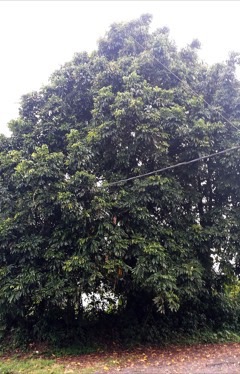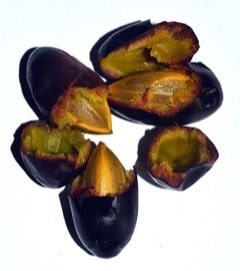 |
|
Muhles wikimedia.org |
 |
| Minette Lontsie wikimedia.org |
Translate this page:
Summary
Note: Canarium schweinfurtii - Engl. often appears online and in text as Canarium schweinfurthii. theplantlist.org show the accepted name as Canarium schweinfurtii.
Physical Characteristics

 Canarium schweinfurtii is an evergreen Tree growing to 30 m (98ft) by 30 m (98ft) at a medium rate.
Canarium schweinfurtii is an evergreen Tree growing to 30 m (98ft) by 30 m (98ft) at a medium rate.
See above for USDA hardiness. It is hardy to UK zone 10. The flowers are pollinated by Insects.
Suitable for: light (sandy), medium (loamy) and heavy (clay) soils and prefers well-drained soil. Suitable pH: mildly acid, neutral and basic (mildly alkaline) soils. It cannot grow in the shade. It prefers moist soil.
UK Hardiness Map
US Hardiness Map
Synonyms
Canarium chevalieri Guill. Canarium khiala A.Chev. Canarium occidentale A.Chev. C. schweinfurthii (incorrect spelling).
Plant Habitats
Edible Uses
Edible Parts: Fruit Oil Seed
Edible Uses: Condiment Gum Oil
The slightly greenish outer pulp of the fruit is oily and edible[303 ]. It can be eaten raw or softened in warm water to improve palatability[303 , 398 ]. It tastes similar to olives and is very popular as a snack among herders and children[398 ]. Often used as a condiment[335 ]. The fruit is about 35mm long[335 ]. The pulp oil is about 71 % palmitic acid and 18 % oleic acid[303 ]. The seed-kernel is oily and edible. It is cooked, and is sometimes prepared into a vegetable-butter and eaten as a substitute for shea-butter[303 ]. The seeds contain several fatty acids including oleic (36 %), linoleic (28 %), palmitic (26 %), stearic (7 %)[303 ]. Carbon Farming - Staple Crop: oil.
References More on Edible Uses
Medicinal Uses
Plants For A Future can not take any responsibility for any adverse effects from the use of plants. Always seek advice from a professional before using a plant medicinally.
Antitussive Diuretic Dysentery Eczema Emetic Emollient Hypotensive Leprosy
Poultice Purgative Skin Stimulant
In the past, the resin was exported to Europe for pharmaceutical use. It was used as a substitute for gum-mastic in making wound dressings in World War II[303 ]. The resin is used against roundworm infections and other intestinal parasites[303 ]. It is an emollient, stimulant, diuretic and has action on skin-affections and eczema[303 ]. The bark is emetic and purgative[303 ]. A decoction is used as a treatment against hypertension, dysentery, gonorrhoea, coughs, chest pains, pulmonary affections, stomach complaints, food poisoning etc[303 , 398 ]. The pounded bark is used against leprosy and ulcers[303 ]. Root is used against adenites whereas root scrapings are made into a poultice[303 ]. The leaves are boiled with other herbs and the decoction used to treat coughs[398 ]. The seeds are roasted and pounded and the resulting powder mixed with skin oil or jelly to treat wounds[398 ].
References More on Medicinal Uses
The Bookshop: Edible Plant Books
Our Latest books on Perennial Plants For Food Forests and Permaculture Gardens in paperback or digital formats.

Edible Tropical Plants
Food Forest Plants for Hotter Conditions: 250+ Plants For Tropical Food Forests & Permaculture Gardens.
More

Edible Temperate Plants
Plants for Your Food Forest: 500 Plants for Temperate Food Forests & Permaculture Gardens.
More

More Books
PFAF have eight books available in paperback and digital formats. Browse the shop for more information.
Shop Now
Other Uses
Adhesive Beads Containers Essential Fuel Furniture Gum Incense Ink Insecticide Lighting Oil Resin Shelterbelt Waterproofing Wood
The bark exudes a heavy, sticky oleoresin that smells like turpentine and solidifies to a whitish resin. It is obtained by slashing the bark and allowing the colourless expiation to trickle to the ground where it solidifies into a sulphur-yellow opaque resin[303 ]. The resin is used as primitive illuminant and as incense and releases a lavender-like smell[303 ]. The resin burns readily and is used as a bush candle[303 ]. The flame is very smoky and soot is collected as carbon-black from the outside of pots held over it for use in tattooing and to make ink in Liberia[303 ]. The resin is also used to repair broken pottery, for caulking boats and as a gum for fastening arrowheads to shafts[303 ]. The resin contains 8-20 % of an essential oil, the main constituent of which is limonene. It is rich in phellandrenes, and contains also resins and a bitter principle[303 ]. The resin is used as a fumigant against mosquitoes[303 ]. The elemi is often left standing on cleared land to provide shade and has potential as a wind break. It has been planted for reforestation in Uganda[303 ]. The endocarp is used by children as spinning tops[308 ]. The seeds are strung into necklaces or attached to traditional instruments[303 ]. The bark of young trees is split off in Gabon to make boxes[303 ]. The wood is said to secrete oil and is used for canoe making[308 ]. The heartwood is pinkish when fleshly cut but darkens to light brown mahogany colour; it is not slearly demarcated from the 5 - 15cm wide band of sapwood that is white with pinkish reflections. The texture is slightly coarse; the grain interlocked, thus causing a fine striped figure on quarter-sawn boards. The wood is light in weight; very soft; not very durable, being suseptible to fungi, dry wood borers and termites. It seasons slowly but fairly well, though there is a risk of distortion and checking; once dry it is poorly stable in service. works easily, stains and polishes well. Used as a substitute for true mahogany. The timber is used as core veneer, for decorative panelling, parquetry, furniture, flooring and for general utility purposes. Locally, the wood is used for mortars, planks, and canoes[303 , 848 ]. The wood is a good fuel, igniting readily and burning with a lot of heat[303 ].
Special Uses
Carbon Farming Food Forest
References More on Other Uses
Cultivation details
Management: Standard Regional Crop Staple Crop: Oil
A tree of the hot tropical rainforests, growing at elevations from sea level to 1,000 metres[303, 335]. It grows best in areas where the mean annual rainfall is in the range 900 - 1,400mm[303]. Climate: tropical. Humidity: humid. Carbon Farming - Cultivation: regional crop only. Management: standard.
Carbon Farming
-
Management: Standard
Plants grow to their standard height. Harvest fruit, seeds, or other products. Non-Destructive management systems.
-
Regional Crop
These crops have been domesticated and cultivated regionally but have not been adopted elsewhere and are typically not traded globally, Examples in this broad category include perennial cottons and many nuts and staple fruits.
-
Staple Crop: Oil
(0-15 percent protein, 16+ percent oil). Some of these are consumed whole while others are exclusively pressed for oil. Annuals include canola, poppyseed, maize, cottonseed, sunflower, peanut. Perennials include high-oil fruits, seeds, and nuts, such as olive, coconut, avocado, oil palm, shea, pecan, and macadamia. Some perennial oil crops are consumed whole as fruits and nuts, while others are exclusively pressed for oil (and some are used fresh and for oil).
References Carbon Farming Information and Carbon Sequestration Information
Temperature Converter
Type a value in the Celsius field to convert the value to Fahrenheit:
Fahrenheit:
The PFAF Bookshop
Plants For A Future have a number of books available in paperback and digital form. Book titles include Edible Plants, Edible Perennials, Edible Trees,Edible Shrubs, Woodland Gardening, and Temperate Food Forest Plants. Our new book is Food Forest Plants For Hotter Conditions (Tropical and Sub-Tropical).
Shop Now
Plant Propagation
Seed - pre-soak the seed by immersing it in hot water and then allowing it to cool in the water for 24 hours prior to sowing. The seed can be sown in nursery beds or in situ[303 ]. The ripe fruits should be collected when they fall to the ground and allowed to decompose, the stones should then be separated from the outer fruit coats. Seeds can be stored for a long time[303 ].
Other Names
If available other names are mentioned here
African Elemi, canarium, mupafu, ube osa, mpafu, kenari or mbani
Native Range
AFRICA: Angola, Benin, Burkina, Cabinda, Cameroon, Central African Repu, Chad, Congo, Ethiopia, Gabon, Ghana, Guinea, Guinea-Bissau, Gulf of Guinea Is., Ivory Coast, Liberia, Nigeria, Senegal, Sierra Leone, Sudan, Tanzania, Togo, Uganda, Zambia, Zaïre.
Weed Potential
Right plant wrong place. We are currently updating this section.
Please note that a plant may be invasive in one area but may not in your area so it's worth checking.
None Known
Conservation Status
IUCN Red List of Threatened Plants Status : This taxon has not yet been assessed

Growth: S = slow M = medium F = fast. Soil: L = light (sandy) M = medium H = heavy (clay). pH: A = acid N = neutral B = basic (alkaline). Shade: F = full shade S = semi-shade N = no shade. Moisture: D = dry M = Moist We = wet Wa = water.
Now available:
Food Forest Plants for Mediterranean Conditions
350+ Perennial Plants For Mediterranean and Drier Food Forests and Permaculture Gardens.
[Paperback and eBook]
This is the third in Plants For A Future's series of plant guides for food forests tailored to
specific climate zones. Following volumes on temperate and tropical ecosystems, this book focuses
on species suited to Mediterranean conditions—regions with hot, dry summers and cool, wet winters,
often facing the added challenge of climate change.
Read More
Expert comment
Author
Engl.
Botanical References
Links / References
For a list of references used on this page please go here
A special thanks to Ken Fern for some of the information used on this page.
Readers comment
| Add a comment |
|
If you have important information about this plant that may help other users please add a comment or link below. Only comments or links that are felt to be directly relevant to a plant will be included. If you think a comment/link or information contained on this page is inaccurate or misleading we would welcome your feedback at [email protected]. If you have questions about a plant please use the Forum on this website as we do not have the resources to answer questions ourselves.
* Please note: the comments by website users are not necessarily those held by PFAF and may give misleading or inaccurate information.
To leave a comment please Register or login here All comments need to be approved so will not appear immediately.
|
Subject : Canarium schweinfurtii
|
|
|
|